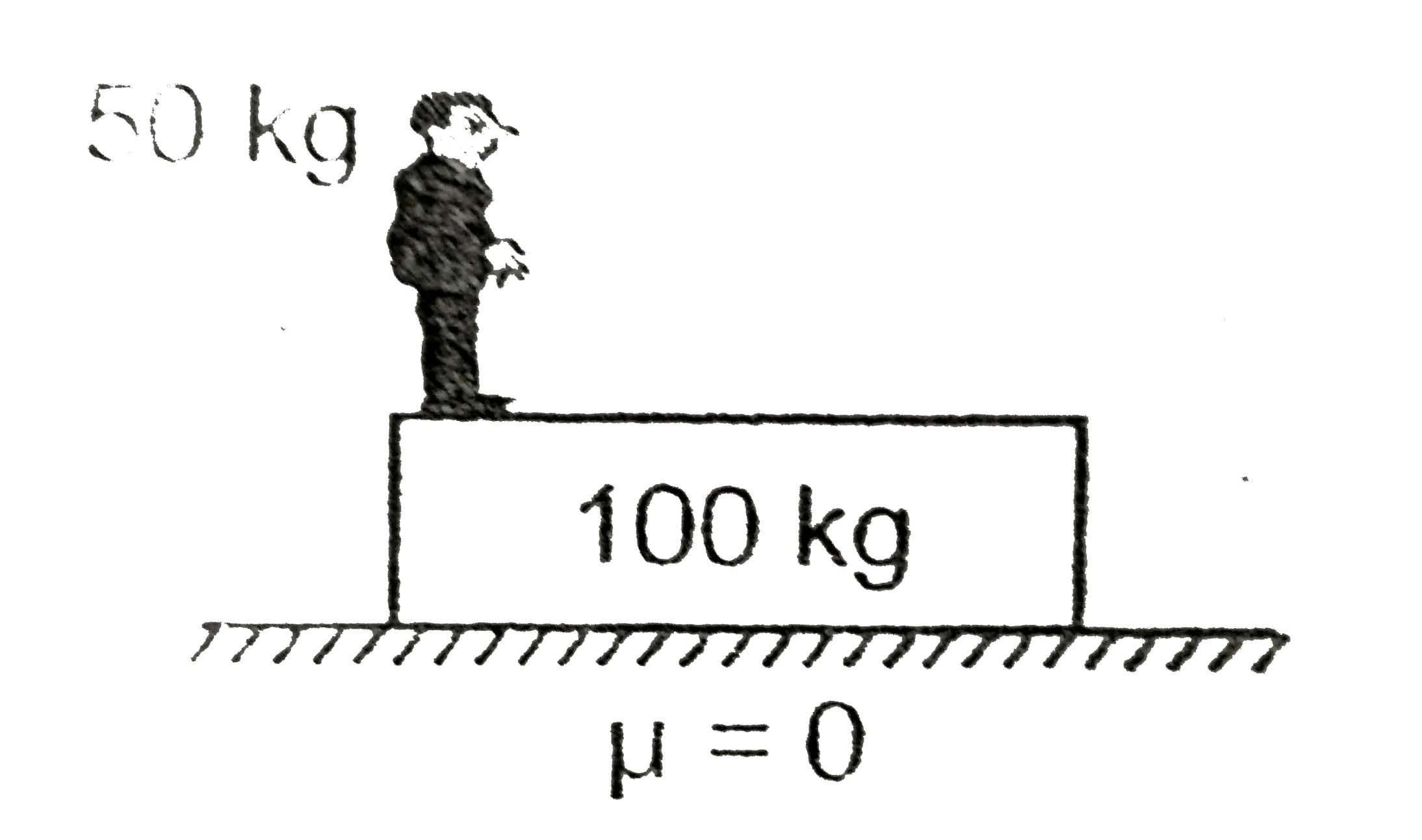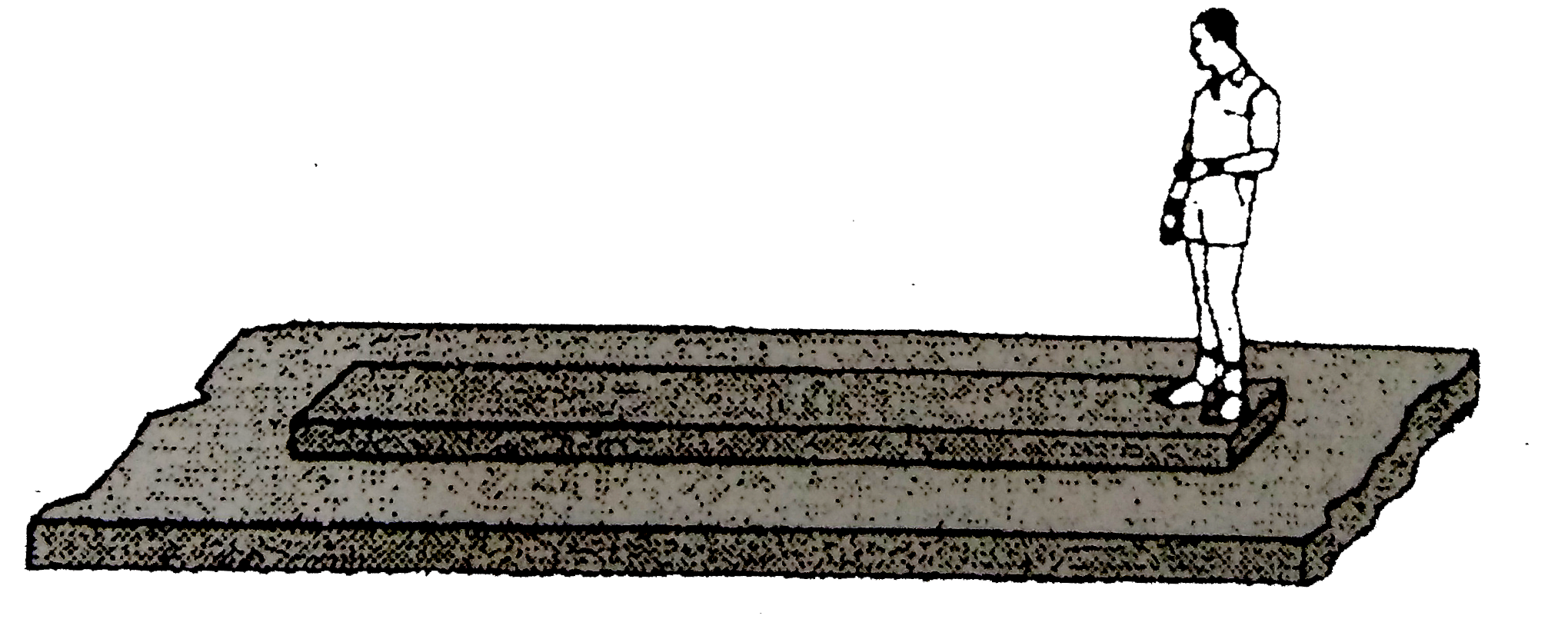A man weighing is standing on a trolley weighting . The trolley is resting on frictionless horizontal rails. If the man starts walking on the trolley along the rails at speed (w.r.t. to trolley) then after his displacement relative to the ground will be :
5 m
4.8 m
3.2 m
3 m
The correct Answer is:C
To solve the problem step by step, we will analyze the situation using the principles of conservation of momentum and relative motion.
Step 1: Understand the System
The man weighs 80 kg and is standing on a trolley that weighs 320 kg. The trolley is on a frictionless horizontal surface, meaning there are no external horizontal forces acting on the system.
Hint: Remember that in a frictionless system, the total momentum before and after any event must remain constant.
Step 2: Initial Momentum
Initially, both the man and the trolley are at rest. Therefore, the initial momentum of the system is:
Initial Momentum=(80kg+320kg)×0m/s=0kg m/s
Hint: The total momentum of a system at rest is zero.
Step 3: Define Velocities
Let Vp be the velocity of the trolley after the man starts walking. The man walks at a speed of 1 m/s relative to the trolley. Thus, the velocity of the man relative to the ground will be:
Vm=Vp+1m/s
Hint: Use the concept of relative velocity to express the man's speed in terms of the trolley's speed.
Step 4: Final Momentum
According to the conservation of momentum:
Final Momentum=Initial Momentum
This gives us:
80kg⋅(Vp+1)+320kg⋅Vp=0
Hint: Set up the equation based on the final momentum being equal to the initial momentum.
Step 5: Solve for Vp
Expanding the equation:
80Vp+80+320Vp=0
Combining like terms:
400Vp+80=0
Solving for Vp:
400Vp=−80⟹Vp=−80400=−15m/s
Hint: Isolate Vp to find the velocity of the trolley.
Step 6: Calculate the Man's Velocity
Now substituting Vp back into the equation for the man's velocity:
Vm=Vp+1=−15+1=45m/s
Hint: Ensure you correctly add the velocities to find the man's speed relative to the ground.
Step 7: Calculate Displacement
To find the displacement of the man relative to the ground after 4 seconds:
Displacement=Vm×t=(45m/s)×4s=165m=3.2m
Hint: Use the formula for displacement, which is velocity multiplied by time.
Final Answer
The displacement of the man relative to the ground after 4 seconds is 3.2 meters.
The man weighs 80 kg and is standing on a trolley that weighs 320 kg. The trolley is on a frictionless horizontal surface, meaning there are no external horizontal forces acting on the system.
Initially, both the man and the trolley are at rest. Therefore, the initial momentum of the system is:
Initial Momentum=(80kg+320kg)×0m/s=0kg m/s
Let Vp be the velocity of the trolley after the man starts walking. The man walks at a speed of 1 m/s relative to the trolley. Thus, the velocity of the man relative to the ground will be:
Vm=Vp+1m/s
According to the conservation of momentum:
Final Momentum=Initial Momentum
This gives us:
80kg⋅(Vp+1)+320kg⋅Vp=0
Expanding the equation:
80Vp+80+320Vp=0
Combining like terms:
400Vp+80=0
Solving for Vp:
400Vp=−80⟹Vp=−80400=−15m/s
Now substituting Vp back into the equation for the man's velocity:
Vm=Vp+1=−15+1=45m/s
To find the displacement of the man relative to the ground after 4 seconds:
Displacement=Vm×t=(45m/s)×4s=165m=3.2m
The displacement of the man relative to the ground after 4 seconds is 3.2 meters.
Similar Questions
A man of mass m is standing on a stationary flat car of mass M. The car can move without friction along horizontal rails. The man starts walking with velocity v relative to the car. Work done by him
View SolutionA man of mass 50kg us standing on a 100kg plank kept on a fricitonless horizontal floor. Initially both are at rest. If the man starts walking on the plank with speed 6m/s towards right relative to the plank, then amount of muscle energy spent by the man is
 View Solution
View Solution
Knowledge Check
- Question 1 - Select One
A man weighing 60 kg is standing on a trolley weighing 240 kg. The trolley is resting on a frictionless horizontal rails. If the man starts walking on the trolley along the rails at speed 1m/s, then after 4 seconds, his displacement relative to the ground will be
A6 mB4.8 mC3.2 mD2.4 m
A man of mass m is standing on a plank of equal mass m resting on a smooth horizontal surface. The man starts moving on the plank with speed u relative to the plank. The speed of the man relative to the ground is
 View Solution
View SolutionA man of mass m is standing at one end of of a plank of mass M. The length of the plank is L and it rests on a frictionless horizontal ground. The man walks to the other end of the plank. Find displacement of the plank and man relative to the ground.
 View Solution
View SolutionA block of mass M is tied to one end of a massless rope. The other end of the rope is in the hands of a man of mass 2M as shown in Fig. The block and the man art resting on a rough wedge of mass M. The whole system is resting on a smooth horizontal surface. The man starts walking towards right while holding the rope in his hands. Pulley is massless and frictionless. Find the displacement of the wedge when the block meets the pulley. Assume wedge is sufficiently long so that man does not fall down.
 View Solution
View SolutionA man of mass m is standing at one end of a trolley of mass Mand length L placed at rest on a smooth horizontal surface. The man starts moving towards the other end and covers distance L, then distance moved by man w.r.t ground is
View SolutionA man of mass 60 kg is standing on a boat of mass 140 kg, which is at rest in still water. The man is initially at 20 m from the shore. He starts walking on the boat for 4 s with constant speed 1.5 m/s towards the shore. The final distance of the man from the shore is
View SolutionA man of mass 80kg stands on a plank of mass 40kg. The plank is lying on a smooth horizontal floor. Initianlly both are at rest. The man starts walking on the plank towards north and stops after moving a distance of 6m on the plank. Then
View SolutionA man weighs 80kg . He stands on a weighing scale in a lift which is moving upwords with a uniform acceleration of 5m/s2 . What would be the reading on the scale?
View Solution

